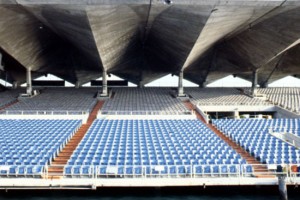
The study of historic thin shell structures shows how masterpieces of Mid Century Modern Architecture were realised without complex mathematical analysis or numerical techniques but with solid foundation in simplified yet realistic structural performance and construction practice.. Historic knowledge studies how successful past designs, such as the shells of the Miami Marine Stadium, advanced in the light of limited scientific knowledge and cost restrictions. In 2009 the USA National Trust for Historic Preservation put the Stadium on the list of America’s 11 Most Endangered Historic Places. This paper briefly reviews the roof’s construction history, reconstructs its originalstructural analysis, and confirms its validity through a comparative study of 4 Finite Element Models. These models conceptualize the roof as a folded plate or a hypar shell, analyse the structural influence of stiffeners and groin thickening and investigates the connection between numerical results and physical observed crack patterns. Generally, this paper allows a better constructional and structural understanding of one of the successful Modern Architectural masterworks, and of simplified and complex folded plate and shell analysis models. The paper also demonstrates how the close link between analysis interpretation and actual structural phenomena can inform decisions about the structural integrity of historic structures.
Adriaenssens S., Brown N., Lowinger R., Hernandez J. (2012). ‘Structural Analysis of Reinforced Concrete Folded Hyperbolic Paraboloid: a case study of the Modern Miami Marine Stadium’. In: International Journal of Architectural Heritage.
Photo Courtesy: Friends of Miami Marine Stadium http://www.marinestadium.org/